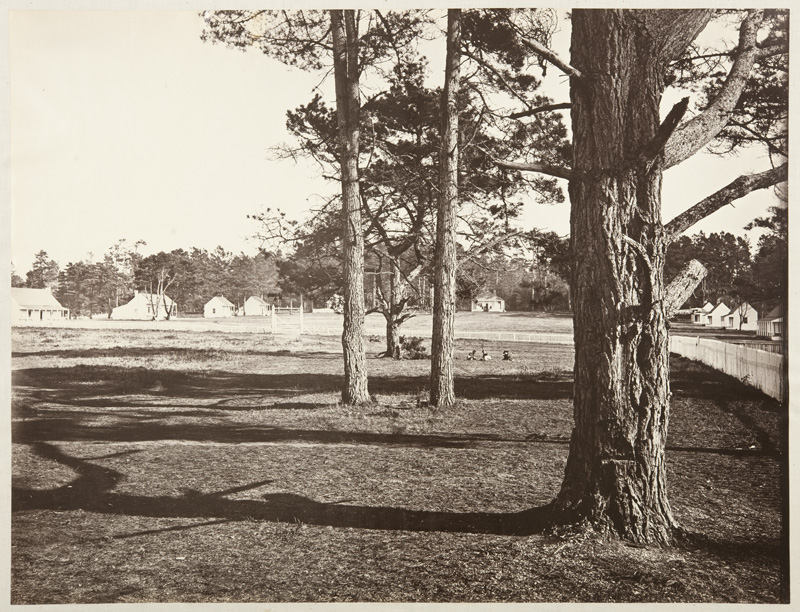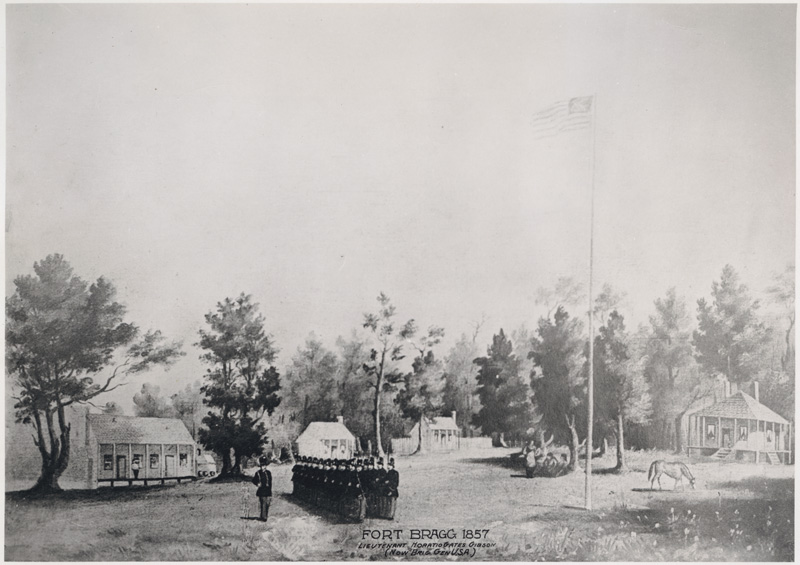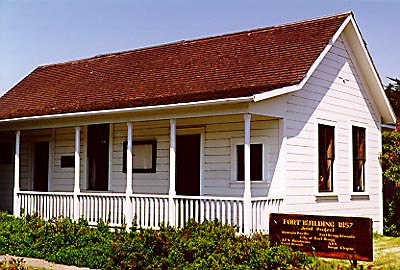

Established in June 11, 1857, Fort Bragg was located about 50 miles south of Cape Mendocino and situated one and a half miles north of tile Noyo River, at the present town of Fort Bragg, Mendocino County. It was established within the Mendocino Indian Reservation for the purpose of both controlling and safeguarding the area's Indians. Established by 1st Lieutenant Horatio Gates Gibson, 3rd Artillery with a detachment from Company M, the post was named for Captain Braxton Bragg, 3rd Artillery, a Mexican War veteran and later a general in the Confederate Army. There was a period of agitation to have the post's name changed because of his disaffection but the post retained the name during the Civil War.
In September 1864 many Army units serving in the Humboldt district were ordered south. The steamer Panama left Humboldt Bay October 18, 1864, picked up the Fort Brag g garrison the next day, and arrived at the Presidio of San Francisco on October 20. This constituted the permanent evacuation and abandonment of the post. The Mendocino Indian Reservation was discontinued in March 1866, and tile land opened for settlement several years later.

A young lieutenant's respect for his first company commander provided the name for Fort Bragg. The respect of others for the same officer caused that name to be retained throughout the Civil War.
Second Lieutenant Horatio G. Gibson was fresh from West Point when he joined the 3d Artillery in time for the Battle of Chapultepec, Mexico, in 1847. A lasting impression was made on him by his captain, Brevet Lieutenant Colonel Braxton Bragg, three times breveted in 15 months.
Ten years later when First Lieutenant Gibson established an Army post on the Mendocino Indian Reservation in northern California, he had no hesitation regarding a name. Colonel Bragg had left the Army in favor of the life of a Louisiana planter, confining his government service by 1856 to serving as his state's Commissioner of Public Works. By naming the new camp after this hero of Buena Vista, Gibson felt that at least the Bragg name was back in the service of the Army.
For an artilleryman, the early days of Fort Bragg were especially trying. Men who had been recruited and trained as cannoneers of the 3d Artillery found themselves performing the age-old Army chores of artisans, masons, and hewers of wood.
"It is slow work, owing to the scarcity of proper tools," reported Gibson on June 18, 1857, a week after officially establishing the post. I do not expect to have all necessary buildings completed before the beginning of the rainy season."
Three months later Gibson could report some progress and the hope of having his command under cover before winter. "I have to report the erection and occupation of three buildings, all of which however are unfinished," he wrote. "The men are now at work on the officers' quarters, which ought to be completed within a month. A stable, guardhouse and storehouse have yet to be built."
The artilleryman came through in this report with a request that the post be provided with its allowance of howitzers.
Fort Bragg was a year old when almost the entire garrison was suddenly rushed to eastern Washington for the Coeur d'Alene War. Gibson was sick when the call came. He ordered 15 of his men to respond to the call. Ten days later he followed them, placing a noncommissioned officer in temporary charge of the post.
Gibson returned to Bragg for a short time after the end of the Coeur d'Alene War, then moved on to be the quartermaster of his regiment. After Civil War duties as a colonel and brevet brigadier general of the 2d Ohio Artillery Volunteers and a hero at Antietam, Gibson returned to the 3d Artillery. He was its regimental commander for the last eight years before his retirement in 1891.
The infantry took over Fort Bragg in early 1859 with a 20-man detachment from Company D, 6th Infantry. The entire company arrived in September. This permitted the garrison to seriously pursue the problems of keeping the Indians peaceful and the settlers at a distance. A small detachment was outposted in Round Valley, 40 miles to the northeast, when it became obvious that the rugged terrain and seasonal floods prevented any rapid movement from Fort Bragg.
Complaints were received at various forts in March 1861, that the Indians were plotting to exterminate the whites. The Fort Bragg garrison was ordered to take to the field. "Keep actively engaged moving over the country requiring protection," the 60-man expedition was told. The detachment in Round Valley was moved to a halfway point, lessening the resupply problems and putting it closer to supposed threats.
The company was supplied with several members of a newly recruited 30-man company of Volunteers who signed up for three months. Acquainted with the area, they were employed as guides. "They proved to be of invaluable aid to the regular forces, which, indeed, would have been worthless without them," according to a contemporary and probably exaggerated account.
Soon countercharges were leveled against some of the settlers who were clamoring for Army protection.
"There are several parties of citizens now engaged in stealing or taking by force Indian children from the district in which I have been ordered to operate against the Indians," reported Lieutenant Edward Dillon, commander of the Fort Bragg field detachment. "As many as 40 or 50 Indian children have been taken . . . This brutal trade is calculated to produce retaliatory depredations on the part of the Indians . . . These men keep the Indians constantly on the alert, attacking and chasing them before us and following in our wake for the purpose of obtaining children."
After three months of operations, it appeared that the settler complaints had been satisfied. They were willing to admit that the Army's conduct of the campaign "inspired a hopeful confidence in their good judgment and soldierly qualities," said a contemporary account. When this resulted in the discharge of the 90-day guides, the writer was quick to announce that the Army had "seized the first opportunity to make a serious mistake . . . The regular soldiers could not fight without the aid and encouragement of the Volunteers, and the Indians knew it. They feared the Volunteers only." The regulars had similar feelings about the Volunteers, usually suggesting that the Indians feared the undisciplined Volunteers because of the brutal punishments they rendered on any unfortunate captive.
Ironically the longtime Volunteers who took over the post from the regulars in November 1861, had the same opinion of the short-time volunteers. "The mingling of the Humboldt volunteers with the men of my regiment at the same post would be demoralizing and dangerous to the discipline that they have been 18 months acquiring," stated the commander of the 2d Infantry Regiment, California Volunteers.
One of the final actions of the regular Army before the arrival of the Volunteers was a visit by the Acting Inspector General of the Pacific, Lieutenant Colonel Don Carlos Buell. Noting that outposts were still being sent to Round Valley and the intermediate point, be commented, "Their services are of no value whatever where they are, and I recommend that they be immediately returned to their company."
Buell passed to the Bragg commander "to make no more attacks on Indians except for depredations actually committed." Noting that the Indians at Shelter Cove, 40 miles up the coast, had yet to be punished for a recent murder, be ordered Bragg's garrison "to take measures for the effectual punishment of that band."
Buell confined the mission to a Fort Bragg detachment on the theory that even if it were defeated, "the Indians will slacken their vigilance" and other forces could attack them successfully. The expedition did not fail, however, nor did several others that returned to the Shelter Cove trouble spot for the next two years.
The garrison was usually suspicious of where the guilt really lay when Indians were charged. On one Shelter Cove campaign, Captain J. B. Moore relayed the report that a settler "took a child from a squaw who happened to be a little to the rear of the party, tied it to a tree, and shot it." The same man was accused of shooting a defenseless woman to death on a previous trip. The Army was powerless to discipline the citizens, however, and insisted that certain white men were committing depredations "in order to get employment as guides, packers, and business for the horses, mules etc."
Buell went on to other actions in the Civil War, coincidentally reaching his peak as a major general of Volunteers in command of Federal troops that defeated the Confederate Army of the Tennessee, General Braxton Bragg, C.S.A., commanding.
Bragg's acceptance of a Confederate commission prompted the commander of the 2d Infantry California Volunteers to recommend a new name for Fort Bragg, "which has long enough borne the name of a traitor." Nothing came of the suggestion, perhaps because Bragg was out of the Army when be joined the Confederacy, or because his Mexican War comrade-in-arms, Brigadier General George Wright, could still remember the heroism at Buena Vista.
Until the post was abandoned in October 1884, the Fort Bragg name was retained, one of the few named after Confederates that did so.
Today, only the Commissary and a state historic marker, both pictured below, are all that remains of this post.


TO GET THERE: Town of Fort Bragg grew up on Army site after area was opened to settlement in 1867. It is on State 1 about 150 miles north of San Francisco. Parade ground was bounded by modern Laurel Street on north between Franklin and McPherson; point about 100 feet south of Redwood street was southern boundary. Main street bisects parade somewhat west of center; state marker for fort is on stone near hospital site at 321 Main Street.


| B | Barracks |
| CEM | Cemetaries |
| COMM | Commissary |
| EM & LAUN | Married Enlisted and Laundress Quarters |
| GH | Guardhouse |
| H | Hospital |
| OQ | Officers' Quarters |
| QM | Quartermaster |
| ST | Stable |

This page was reprinted with permission from Pioneer Forts of the Far West, published in 1965
Additional Online Histories